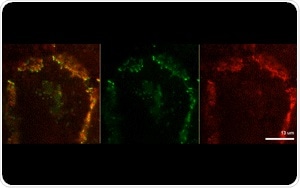Scientists from Northwestern Medicine headed a new study that determined the molecular mechanisms inside protein complexes that support cell-to-cell adhesion and communication. The study results have been published in the Proceedings of the National Academy of Sciences.

A431 cells expressing Dendra2-tagged E-cadherin were briefly stained and then immediately imaged simultaneously in green and red channels. Image Credit: Northwestern University Feinberg School of Medicine.
The senior author of the study was Sergey Troyanovsky, PhD, professor of Dermatology and of Cell and Developmental Biology.
Catenins and cadherins are proteins forming multiprotein complexes, binding cells together, and stabilizing cell-cell interactions, thus forming different tissues. Such multiprotein complexes, called cadherin-catenin complexes (CCCs), form clusters. However, how other CCC-related proteins are enrolled into these clusters and how they influence the overall clustering process has so far remained less investigated, says Troyanovsky.
The researchers employed mass spectrometry and cross-linking, a proteomics technique that involves chemically “linking” two or more neighboring molecules by a covalent bond, and found that a majority of the CCC-related proteins interact with CCCs outside of adherens junctions, or protein complexes featuring cadherin receptors.
Moreover, structural modeling showed that there is very little space for CCC-related proteins to form clusters in the first place. Then, the researchers investigated two sample CCC-related proteins vital for cell polarity and cell proliferation and discovered that each protein formed individual CCC-related clusters.
The study results show that protein-induced CCC clustering has a role in cell-to-cell adhesion while allowing cells to communicate with each other by coordinating between their signaling networks.
Different proteins which associate with CCC can sort cadherin into different populations of CCC clusters, and that’s important because it’s actually a mechanism of how signaling units can be equalized in different cells.”
Sergey Troyanovsky, Professor of Dermatology and Cell and Developmental Biology, Northwestern University Feinberg School of Medicine
According to Troyanovsky, who is also a member of the Robert H. Lurie Comprehensive Cancer Center of Northwestern University, the results of the study might also offer better insights into the intracellular mechanisms that cause skin diseases, as a majority of the skin diseases are due to defects in cell-to-cell adhesion inside the epidermis.
Source:
Journal reference:
Troyanovsky, R. B., et al. (2021) Sorting of cadherin–catenin-associated proteins into individual clusters. Proceedings of the National Academy of Sciences of the United States of America. doi.org/10.1073/pnas.2105550118.